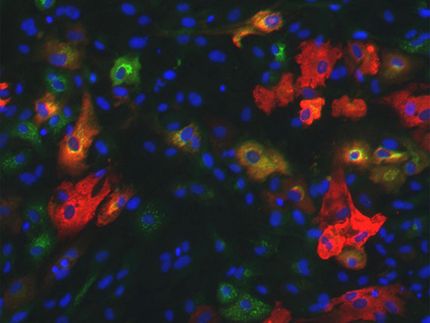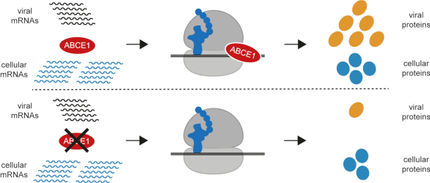A Molecular Toolkit for Gene Silencing
Advertisement
The team of Johannes Zuber at the IMP in Vienna, Austria, managed to overcome remaining key limitations of RNA interference (RNAi) - a unique method to specifically shut off genes. By using an optimized design, the scientists were able to inhibit genes with greatly enhanced efficiency and accuracy. The new method facilitates the search for drug targets and improves the interpretation of experimental results. The IMP will make this „RNAi toolkit“ available to researchers. Results of the study are published in the current issue of Cell Reports.

RNA-interference: small RNA molecules suppress gene expression (artist’s interpretation).
IMP
RNA interference (RNAi) is a regulatory mechanism that occurs naturally within cells. Short pieces of RNA (so-called “hairpins”) interfere with transcribed genetic information to silence genes. RNAi was originally discovered in plants in 1990, and in 2001 was also found in mammals. Right from its discovery, RNAi has inspired scientists to utilize the new mechanism for the development of experimental gene suppression tools. Beyond many applications in basic biological research, RNAi has become a unique method to identify and study therapeutic target genes. However, despite their enormous potential, currently available RNAi reagents are often ineffective or come along with unspecific side-effects.
Inspired by nature
Johannes Zuber and his colleague Christof Fellmann came up with ideas how to improve RNAi technology back in 2010, when both were still working at Cold Spring Harbor Laboratory (CSHL) in the US. “The basic principles of RNAi are not yet fully understood. To shut off a specific gene, one has to test many hairpin molecules, and often only one out of ten will be effective enough. To improve the method, we took nature as an example,” Zuber explains their line of thought. He finally took the project to the IMP, while Fellmann continued his scientific career at Mirimus, a CSHL-based biotech company developing advanced RNAi technologies.
A particularly powerful and commonly used RNAi method is based on embedding synthetic hairpin sequences into naturally occurring „micro-RNA backbones“. The result is an RNA-construct that mimics nature and is processed by normal cellular pathways. However, the performance of existing reagents designed this way remains far from perfect.
Zuber and his team analyzed a human micro-RNA backbone, focusing on sequence parts that remained unchanged during evolution – a sign that they may have important functions. The scientists realized that some of these sequences had been altered in the commonly used synthetic RNAi backbone. By correcting these differences and systematically testing many design variants, Zuber and his team managed to greatly improve the effectiveness of the synthetic RNAi tool.
Upgrade from a Beetle to a Lamborghini
“The benefit for science is tremendous” Zuber points out the relevance of his results. While current methods involve testing up to twenty hairpins to strongly suppress a given gene, the optimized reagents cut down the number to an average of four. Moreover, in high-throughput screening studies it will be easier to nominate positive hits and interpret negative results.
“We are taking the technology from a molecular Beetle to a Lamborghini” Zuber draws an analogy. “The upgrade is simple and existing reagents can be adapted with minimal effort.” Zuber and his co-workers at the IMP provide the new method and reagents - an “entire toolbox for effective RNAi”, as he calls it - to the scientific community. Cooperation partners and colleagues at the IMP who have already tested these new reagents are fully convinced of the benefits.
Improvement for the search of new drugs
In the future, Zuber’s study will allow a better exploitation of the potential of RNAi in cancer research. Despite tremendous efforts, pharmaceutical companies have not yet managed to develop RNAi as a drug in humans. However, large-scale “RNAi screens” represent a unique procedure to find and test the most promising target genes for new drugs before launching the slow and expensive process of developing a new drug. The optimized RNAi reagents are especially useful for such high-throughput screens, as more genes can be tested simultaneously with higher efficiency and precision. And, most importantly, introduction of the optimized RNAi tools will reduce the risk of missing promising targets for future therapeutic use.




























































